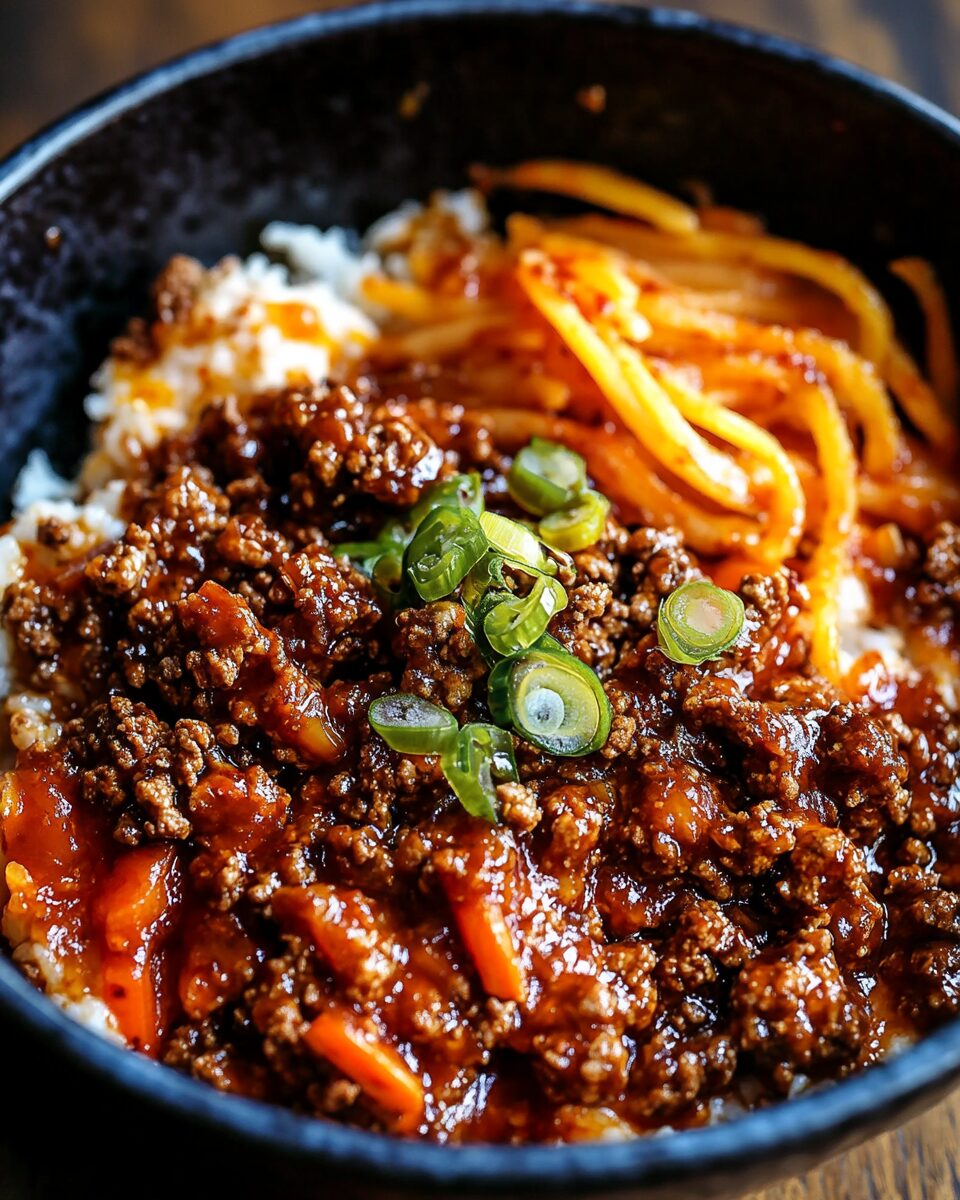The Gochujang Beef Bowl is a beautiful fusion of bold Korean heat and everyday ease. With ground beef simmered in spicy-sweet gochujang sauce, nestled over fluffy jasmine rice, and topped with crunchy carrots, cabbage, cucumber, and fresh herbs—this dish brings a rainbow of flavor and texture to your table.
Whether you’re looking for a quick weeknight dinner or something exciting for meal prep, this 30-minute bowl delivers every time. It’s versatile, hearty, and easily customizable—add an egg for richness, kimchi for tang, or go extra with pickled veggies and a drizzle of sesame oil.
Full Recipe
Ingredients:
-
1 lb ground beef
-
1 tablespoon sesame oil
-
3 cloves garlic, minced
-
1 tablespoon freshly grated ginger
-
1/3 cup Gochujang (Korean chili paste)
-
2 tablespoons soy sauce
-
2 tablespoons rice vinegar
-
1 tablespoon honey
-
1 tablespoon toasted sesame seeds
-
2 green onions, thinly sliced
-
1 cup jasmine rice (or rice of choice)
-
1 cup shredded carrots
-
1 cup shredded cabbage
-
1 cucumber, sliced thin
-
Fresh cilantro, for garnish
-
Kimchi (optional), for serving
-
Fried or soft-boiled egg (optional), for topping
Directions:
-
Cook rice according to package instructions. Fluff with a fork and set aside.
-
In a large skillet, heat sesame oil over medium heat. Add garlic and ginger, sauté for 1 minute until fragrant.
-
Add ground beef and cook until browned, about 5-7 minutes.
-
Stir in Gochujang, soy sauce, rice vinegar, and honey. Simmer for 2-3 minutes until sauce thickens slightly.
-
Remove from heat and stir in sesame seeds and green onions.
-
In serving bowls, layer rice, followed by the gochujang beef.
-
Top with shredded carrots, cabbage, cucumbers, and fresh cilantro. Add kimchi and a fried or soft-boiled egg if desired.
-
Serve warm with extra sesame seeds or a drizzle of sesame oil if desired.
Prep Time: 15 minutes | Cooking Time: 15 minutes | Total Time: 30 minutes
Kcal: 520 kcal | Servings: 4 servings
What Are Gochujang Beef Bowls?
Gochujang Beef Bowls are a bold and savory dish inspired by Korean culinary traditions, offering the perfect balance of heat, sweetness, umami, and texture. At its core, the dish features ground beef cooked in a deeply flavorful sauce made from gochujang, a fermented Korean chili paste, paired with jasmine or white rice and a variety of fresh, crunchy vegetables. It’s an easy-to-make, satisfying, and colorful one-bowl meal that blends the comforting elements of home-cooked food with the complex flavors of Korean cuisine.
Originating from the broader category of Korean rice bowls (such as bibimbap), this dish has been adapted into a faster, weeknight-friendly version that retains its authentic soul but simplifies the process. In Korean cooking, gochujang is a staple—it’s thick, pungent, sweet, and spicy, all at once. When combined with garlic, ginger, soy sauce, and rice vinegar, it creates a lip-smacking sauce that elevates simple ground beef into something truly special.
The Cultural Backbone of Gochujang
Gochujang (고추장) is a fermented condiment made with chili powder, glutinous rice, fermented soybeans, and salt. Its history dates back centuries and it plays a foundational role in Korean gastronomy. Unlike sriracha or other chili sauces, gochujang is fermented, giving it a complexity that goes beyond heat. It brings a deep umami flavor with underlying sweetness that pairs exceptionally well with meats, especially beef and pork.
Using gochujang in a rice bowl is a nod to dishes like bibimbap and bulgogi-based rice bowls, where sauces and seasonings are key to developing rich, layered flavors. The rise of Korean food across global kitchens has turned gochujang into a pantry essential in many households beyond Korea, making dishes like this more accessible and easier to prepare than ever before.
Flavor Profile and Texture Experience
This dish is a party for the palate. The gochujang beef is juicy and rich with a glossy, slightly sticky sauce that clings to each bite of meat. It brings a heat that’s more flavorful than it is fiery—warmth that builds but doesn’t overpower. The soy sauce adds saltiness, while the honey or sugar used in the sauce tempers the spice, balancing it all out.
The base of fluffy jasmine rice soaks up every bit of that savory-spicy sauce. Crunchy fresh vegetables—think shredded carrots, cabbage, and cucumber—bring a refreshing crispness to contrast the warm, saucy beef. Cilantro and green onions add a herby brightness. Optional toppings like kimchi provide tang and fermentation, while a soft-boiled or fried egg lends richness and silkiness that ties the whole dish together.
This dynamic contrast of temperatures and textures is what makes Korean bowls so addictive: the interplay of hot and cold, cooked and raw, spicy and sweet, soft and crunchy. Every bite is different, but it always feels complete.
Why This Dish Is Perfect for Home Cooks
One of the best things about Gochujang Beef Bowls is how fast and approachable they are. You can have this dish on the table in about 30 minutes, making it ideal for busy weeknights or last-minute cravings. Ground beef is readily available and affordable, and gochujang is now found in most supermarkets or online stores, making it easier than ever to bring Korean flavors into your home.
Unlike more traditional Korean meals that require fermenting, marinating overnight, or several side dishes (banchan), this dish streamlines the process without sacrificing flavor. It also requires just one skillet and a pot of rice, meaning minimal cleanup.
The dish is also highly customizable—perfect for picky eaters or households with different dietary preferences. You can make it gluten-free with tamari or coconut aminos, low-carb by swapping rice with cauliflower rice, or vegetarian by using crumbled tofu or mushrooms instead of beef.
Tips to Customize and Make It Your Own
One of the joys of a rice bowl is that it’s a canvas—you can get creative without compromising the essence of the dish. Here are a few ways to switch things up:
-
Protein options: Substitute ground beef with ground turkey, chicken, pork, or even plant-based meat alternatives. Tofu and tempeh are also great vegan substitutes that soak up the gochujang sauce beautifully.
-
Grains: Try brown rice, wild rice, quinoa, or even noodles as a base instead of white rice.
-
Vegetables: Add sautéed mushrooms, blanched spinach, pickled radish, avocado, or edamame for a nutritional and visual boost.
-
Egg style: Swap the soft-boiled egg for a sunny-side-up, poached, or even a jammy 6-minute egg depending on your preference.
-
Spice level: Adjust the amount of gochujang or add a splash of sriracha or chili crisp if you want more heat.
This adaptability makes it a great meal prep option—you can make a big batch of beef and rice and switch up the veggies and toppings throughout the week to keep things exciting.
Nutritional Value and Health Benefits
Gochujang Beef Bowls, while indulgent and flavor-packed, can also be part of a well-balanced meal. Ground beef is a great source of protein, iron, and B vitamins. The vegetables add fiber, antioxidants, and crunch without the need for heavy sauces or dressings.
Gochujang itself, being fermented, may offer some probiotic benefits, although it should be consumed in moderation due to its sodium content. Using whole grains or increasing the ratio of vegetables to rice can boost the nutritional profile significantly.
For those watching their sugar or sodium intake, the sauce can be easily adjusted. Opt for low-sodium soy sauce and reduce the sweetener if desired. Overall, this dish offers a great way to enjoy comfort food that doesn’t feel like a nutritional compromise.
Why People Love It
This dish has become a favorite among home cooks and foodies alike for many reasons:
-
Easy and quick to make
-
Packed with bold, craveable flavors
-
Visually vibrant and Instagram-worthy
-
Adaptable for different diets
-
Great for meal prep and leftovers
-
Fills you up without feeling heavy
It strikes a rare balance between comfort food and something exciting and global. It’s familiar, but with just enough spice and umami to feel like an adventure.
Conclusion
Gochujang Beef Bowls are more than just a recipe—they’re a flavor journey that takes your everyday ingredients and transforms them into something vibrant, nourishing, and utterly satisfying. With the perfect combination of spicy-sweet beef, soft rice, and crunchy fresh toppings, this dish celebrates balance in every bite.
It’s fast, it’s flexible, and it’s a fantastic introduction to Korean flavors for the uninitiated, while still being satisfying for those who already love the cuisine. Whether you’re looking to spice up your weekly dinner routine or meal prep something that doesn’t get boring by day three, this recipe checks all the boxes.
So grab your skillet, open that jar of gochujang, and get ready to turn your kitchen into a Korean-inspired flavor haven.






